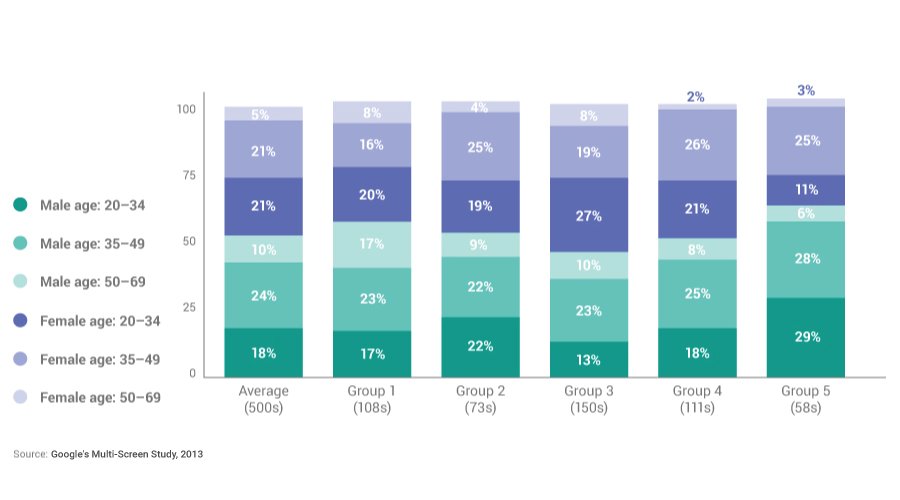What are the different ways people use media today? “Multi-screen behavioral analysis” collects second-by-second log data on people’s engagement with their TV, computers, and smartphones to uncover how individuals use different devices. The analysis reveals how today’s realities are vastly different from traditional segmentations, such as demographics. This is the third in a series of articles exploring the changing nature of marketing.
The previous article pointed out that, with the constantly changing media environment, marketers’ predictions based on past experiences may (unintentionally) be biased. The article also detailed the importance of objectively and constantly assessing the actual behavior, while keeping in mind the variables surrounding the individual, in order to avoid biased decision-making. This article aims to shed light on how the diversifying media environment, and the consumption of it, has changed people’s exposure to information and the way it is being consumed.
The ways we obtain information
Imagine the following: What would you do right away if you wanted to find out tomorrow’s weather? Would you watch the forecast on TV? Or would you check it on a site via your computer? Perhaps you’d open a weather app or use Google Now on your phone? Clearly, there are many ways and places we can acquire this information, and it’s common to use whatever works best in a given situation.
Now, consider this: 43%1 of Japanese people today have personal access to TV, a computer, and a smartphone. They can get the same weather information from any of these devices. Yet, even if we studied the smartphone penetration rate or TV show ratings, we’d still have no way of telling methods was the source. Similarly, questionnaires asking “How do you find tomorrow’s weather?” unfortunately result in respondents indicating that they use all three, making it difficult to know exactly how the desired information was obtained.
So how do people get certain information, be it about the weather or new products? It’s a marketer’s dream to know the answer, but as there’s no science to uncover such information, the next closest thing are extensive questionnaires that accumulate segmentation data. For example, these questionnaires can show that women in their 20s tend to do “this,” while men in their 40s have a relatively strong tendency to do “that.” However, the single-source data2 approach, which accumulates individual behavior based log data, enables us break things down into action-based categories, thereby offering new and alternative perspectives from traditional methods of segmentation (in other words, demographics).
"43% of Japanese people today have personal access to TV, a computer, and a smartphone."*
Multi-screen behavioral analysis reveals people’s behavior with information
Multi-screen behavioral analysis3 yields second-by-second behavior log data, providing insight into exactly when and how long panelists use their devices (TV, computer, and smartphone). In our study, we used clusters that statistically categorize people with similar usage patterns to reveal five distinct groups. (Note: The data was provided by a third-party research firm and is not owned by Google.)
We then uncovered a wealth of detailed characteristics of each of the five groups using a combination of the following: exposed content information (TV programs viewed, internet sites browsed, apps used); survey results on purchase awareness and lifestyle awareness; and demographic information such as gender, age, and occupation.
Group 1 (22% of total): This group constantly uses devices, turning them on as they wake up in the morning; reads many magazines and accumulates knowledge through news and informational TV programs; tends to add new media sources rather than picking and choosing from a few.
Group 2 (15% of total): mostly watches TV at night and rarely during other times of the day; also uses the computer at night. Smartphone usage is relatively low compared to computer use. Rarely reads magazines.
Group 3 (30% of total): uses the TV, computer, and smartphone for fun. Prefers variety shows on TV and takes photos and watches online videos on smartphones. When at home, uses the computer or smartphone while the TV is on.
Group 4 (22% of total): For this group, the smartphone has surpassed the computer as its main device. Likes to look up topics of interest right away. Can’t wait for the computer to boot up, so searches on the smartphone even at home.
Group 5 (12% of total): is on the computer and/or smartphone longer than the TV. Frequent use of the TV/computer/smartphone late at night (11 pm onwards). Uses the Internet to connect with people and obtain information.

All respondents had all three devices: a TV, a computer, and a smartphone. But the way they used the devices was completely different. We further learned that the differences in panelists' behavior consisted in not only their preferences for one device over another, but also the apps they used, the sites they accessed, and the TV programs they watched. Also noteworthy is that we observed no extreme differences when it came to gender or age within each group.
The typical Japanese household used to consist of a “four-person household with a husband, a wife and two kids.” The wife was a homemaker or held a part-time job while the husband provided for the family. Needless to say, this model of the Japanese family is no longer the standard. With this in mind, a media plan targeting women in their 30s, with a sole focus on TV, will no longer have the impact it might have had two decades ago. In fact, the model of social behavior for women in their 30s has changed drastically over the past 20 years, and now women obtain information through various means. Trying to fit all women “in their 30s” into one target group will invariably result in the neglect of their actual behaviors.
"The differences in panelists' behavior consisted in not only their preferences for one device over another, but also the apps they used, the sites they accessed, and the TV programs they watched."
Throw out the percentages
Market research is constantly innovating. Methods that were once costly and complicated have now become accessible and affordable. And yet, many marketers and researchers may still be influenced by conventional quantitative research, chasing after percentages.
By nature, consumer analysis should be accurate and objective when it comes to analyzing, classifying, and assessing consumer behavior through data. An approach that was deemed second best in the past, due to high costs or complications, may now, with advent of high technology, be used as the most appropriate approach.
In marketing, understanding the intended audience is as important as creating love for a brand’s products and services. Rather than in the conventional classifications—gender, age, loyal users, etc.—the future of marketing lies in analyses that gain insights into actual consumer behaviors.
The next article in this series will illustrate examples of how we can understand consumers from this perspective, with a focus on buying behavior-the usual contact point between the consumer and the brand.
This article was originally published on May 22, 2015 in Japanese.






